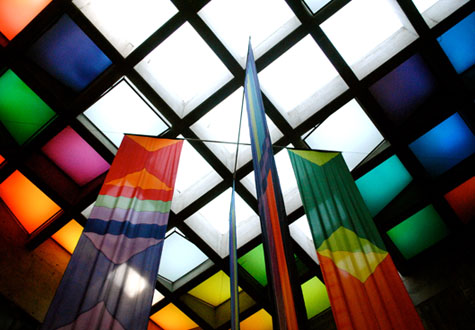When describing the John Labatt Visual Arts Centre (figure 1) on the University of Western Ontario’s (UWO) campus, “idiosyncratic” is the first word that comes to mind. The overall style of the building takes on a Minimalist approach, juxtaposed to the majority of the buildings at UWO that have attributes of a neo-Gothic aesthetic. Accordingly, the John Labatt Visual Arts Centre is representative of a space that values innovativeness. This is demonstrated through the modern motif applied to both the interior and exterior of the building. Some background on the John Labatt Visual Arts Centre is needed in order to understand how its contemporary design has evolved.
The John Labatt Visual Arts Centre, referred to as the “VAC” by UWO students, has had a short, but, meaningful history. It was erected in 1993 with a budget of $10.6 million. Japanese-Canadian architect, Raymond Moriyama, spearheaded the project. Moriyama has established a reputation for his distinct designs in which he experiments with glass panels. The Bata Shoe Museum in Toronto, the Canadian Embassy in Tokyo, and the Ontario Science Centre in Toronto are some of the many projects Moriyama has been associated with. To learn more about Raymond Moriyama and his projects, you can visit his website. It is evident that Moriyama’s Minimalist style was applied to the design of the John Labatt Visual Arts Centre, making the building one of the most unique spaces to visit in London, Ontario.
The exterior of the VAC is very sleek and linear in appearance, which one would deem as modern. The front entrance of the VAC is extremely daring, in that it consists of a large, grey brick, windowless wall with glass entrance doors in the middle. Although this contrast is visually simple, it achieves a dramatic effect. Before entering the building, one must note the small bridge pathway to be followed to enter the space. On the sides of the bridge are plants that transmit a welcoming feeling to the person entering the building. Meanwhile, the left and right sides of the exterior are Moriyama’s signature glass panels, mixed with grey brick and highlighted with red framing. The use of red frames with the glass panels affirms the VAC’s powerful presence.
This unconventional aesthetic, transmitted from the exterior, has also been applied to the interior. When visitors first walk into the John Labatt Visual Arts Centre, they are once again confronted with Moriyama’s style. Highlights of red are present on the door frames, railings, and the pipes hanging from the ceiling. Most of the ceilings have an industrial feel, as the wiring and piping of the building are visible. Yet, there is one spot in particular on the first floor where the ceiling has been opened up to the second floor, and it consists of geometrically constructed glass panels (figure 2) that bring in a radiant flow of natural light. This section of glass-paneled ceiling and the highlights of red brighten up the space. Without these distinct touches, the interior would be an uninviting environment. Hence, once could acknowledge that Moriyama strategically placed these elements so that the interior would be conceived as a visually appealing and pleasant space.
Past the glass ceiling of the VAC, one encounters a multi-functional space. This particular area has been designed to serve as a student lounge area and a mini art gallery (figure 3). On the front left side, there is a sectioned off area with grey cushioned seating. The wall is painted grey with a variety of white-framed posters that mark important events and moments that occurred in the building. Suspended above is the piping and wiring from the ceiling, with some of the pipes painted red to blend in with the aesthetic. In the back, to the left, there is a long, rectangular table with square stools, adorned with grey cushions lined up on each side. Two big windows face the table where natural light comes beaming through. At the back on the right-hand side is a white wall that provides a mini showcase of student art. Miniature spotlights shine onto the wall, accentuating the artwork on display. Another seating area is present on the front right side, which is similar to the one parallel to it on the front left side.
Overall, Raymond Moriyama’s application of colour and play with light render the John Labatt Visual Arts Centre a remarkable piece of architecture. By having a colour palette of red, black, and tones of grey repeated throughout the interior and exterior, a sense of unity is created. Meanwhile, the combination of natural and synthetic light highlight interesting aspects of the space. Although the style of the building does not follow UWO’s neo-Gothic style, the Minimalist design the John Labatt Visual Arts Centre reflects the creative thinkers that emerge from the arts courses taken in the space. |













